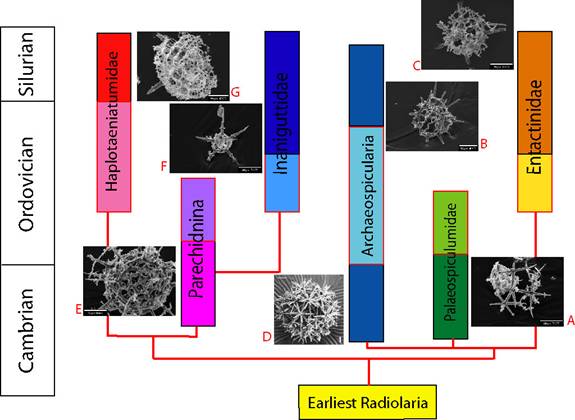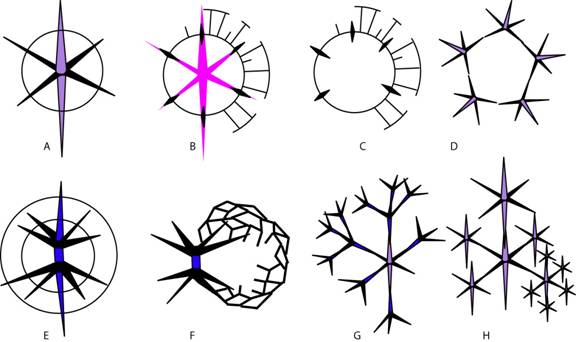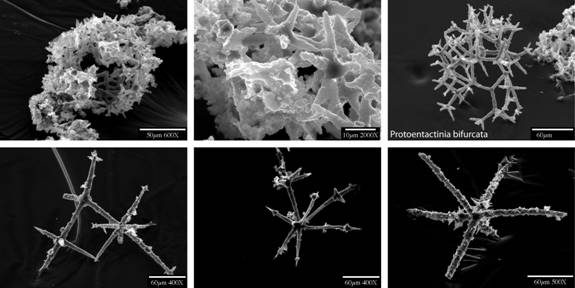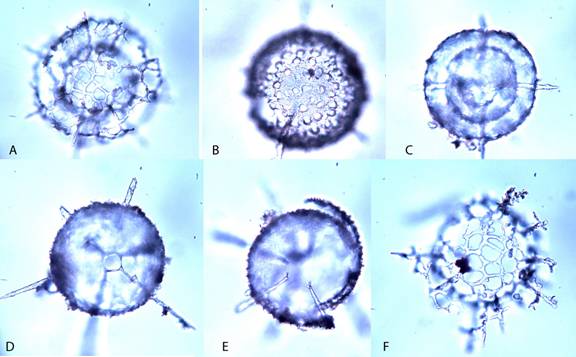
Graptolites Radiolaria Stratigraphy
Radiolaria
Radiolarian Taxonomy & Evolution
Radiolarians are a group of siliceous microfossils with a high biostratigraphic potential, as they show a fast rate of evolution through time. Even though few faunas are described adequately from the early Paleozoic, these show this potential by their distinct compositions. As most radiolarian faunas are etched from silicified rocks, fine details of the tests are often not preserved and a massive bias towards thick shelled and robust forms has to be assumed. The discovery of well-preserved radiolarian faunas in limestone is a rare opportunity to investigate details not found in most faunas and to gain insight into the actual diversity of the faunas, as well as information for a better phylogenetic understanding of this group of skeleton-bearing marine protists.
In recent years more information became available from a number of regions where Cambrian and Ordovician radiolarians have been found in some quantity, enabling a rare glimpse into their early evolution and diversification. As the radiolarian biostratigraphy is based on isolated occurrences from few and widely scattered regions, the ranges of these faunas are not well established. Many of the isolated occurrences are poorly dated by other fossil groups and the biostratigraphic framework was pieced together from various biogeographically unrelated regions.

Figure 1. General trends in radiolarian evolution from the Cambrian to the
Silurian. A. Svalbardospiculum arenigium. B. Secuicolacta
sp., Dalarna, Llandovery. C. Sphaeroentactinia hexaspinosa. D.
Echidnina sp. E. Parechidnina sp.? F. Spumellarian microsphere.
G. Haplotaeniatum sp.? (Maletz, unpublished).
In many species the radiolarian skeleton based on an initial spicule, with associated additional elements forming a more or less regular spherical body. The development of this skeleton can be used to differentiate major groups of radiolarians.

Figure 2. A. Spherical spumellarian with point-centered spicule and shell.
B, C. Spherical spumallarian, spicule preserved as remnants on inner
shell, shown complete in (B), beams connect to outer – incomplete – shell.
D. Spicule association in Echidninids. E. Spherical spumellarian with
bar-centered spicule and two shells. F. Spherical spumellarian with
bar-centered spciule in eccentric position. Shell produced from branched
apophyses. G. Spiculumid with point-centered spicule, distal branching
forms a vaguely spherical shell. H. Palaeospiculum sp. (based on
Maletz & Bruton 2007).
Early
diverse radiolarian assemblages are reported from the Middle Cambrian of
Australia, the late Cambrian to early Ordovician of the Cow Head Group of
western Newfoundland and from Hunan, China. These show a variety of spicular forms identified as Archeoentactiniidae, Echidninidae,
Palaeospiculumidae, Protoentactiniidae and Aspiculumidae.

Figure 3. Early Ordovician radiolarians from western Newfoundland and
Spitsbergen. A, B. Echidnina sp., Pendeograptus fruticosus
Biozone, Spitsbergen. C. Protoentactinia bifurcata, Spitsbergen. D.
Svalbardospiculum arenigium, Spitsbergen. E, F. Spicular forms
indet. Spitsbergen (Maletz, various sources).
In the Arenig, radiolarians with one or more distinct spherical shells
appear as the dominant faunal elements in the fossil record. These forms
are often difficult to distinguish from each other depending on the
preservation. Thus, they are poorly known so far. New and diverse faunas
were recently discovered in western Newfoundland and Spitsbergen,
showing high potential for detailed biostratigraphic use of early
Ordovician radiolarians.

Figure 4. Various Castlemainian (mid-Arenig) spumellarian radiolarians
from Spitsbergen, transmitted light photos. Specimens prepared by
Holdsworth (Collection at Geological Museum, Oslo, Norway, PMO) A,
F. Nyfrieslandia sphaeroidea. B. Antygopora sp. C.
Antygopora microspina. D, E. Antygopora bella (Maletz,
unpublished).
It is often difficult however, to recognize and
identify radiolarians in transmitted light. Comparisons with SEM
photographs are difficult as the SEM shows the surface ornamentation only,
while transmitted light also shows internal skeletal structures – internal
spheres and spicules.

Figure 5. Different preservational aspects in Arenig radiolarians. SEM
photographs. Specimen A is a perfectly preserved, undescribed spherical
parechidninid with numerous slender outer spines. Specimens B and C
represent Antygopora ordovicica, preserved as a broken pyritic
specimen, showing internal and external spheres (B) and (C) an inner
sphere with partial pyritization (lower right corner of photo). The
material comes from the Arenig of the Cow Head Group of western
Newfoundland (Maletz, unpublished).

Figure 6. Beothuka terranova Aitchison, Flood & Malpas. The left
and middle specimens come from the Isograptus victorie lunatus
Biozone of western Newfoundland, while the specimen to the right is from
the Didymograptellus bifidus Biozone of Spitsbergen. The specimen
from Spitsbergen is completely pyritized and thus, the original skeletal
structure is strongly modified. The Newfoundland specimens are preserved
as silica with little modification from the original structure, even
though the original opal-A is recrystallized to quartz.
In the late Middle Ordovician (Darriwilian) the radiolarian faunas changed
considerably and new faunal elements appear. In general, the species that
are
much larger and have spicular forms are extremely rare. Spherical species of
the Inaniguttidae with a variable number of spheres connected by spines
and beams are associated with labyrinthine species.

Figure 7. Radiolarians and sponge spicule from the Middle Ordovician Table
Head Group, western Newfoundland, upper part of Holmograptus lentus
to Nicholsonograptus fasciculatus Biozone at the West Bay Centre
Quarry, Port-au-Port Peninsula. A. ?Inanibigutta sp. B. Spongy,
bipolar radiolarian, one of the main outer spines broken. C. Sponge
spicule.
In the Llandovery, the radiolarian faunas are dominated by the
Secuicollactidae, represented by small spherical radiolarians with a
variable number of primary units or spicules. They are similar in their
development to the late Cambrian to early Ordovician Echidninidae. The
species are associated with various labyrinthine radiolarians of the
genera Haplotaeniatum, Gyrosphaera and Labyrinthosphaera
and various spicular radiolarians.

Figure 8. Radiolarians from the Llandovery (early Silurian) of Solberga,
Dalarna, Sweden. A. Diparvapila sp. B. Gyrosphaera raneatela.
C. Labyrinthosphaera macdonaldi. The specimens are associated with
graptolites indicating the Streptograptus sartorius Biozone.